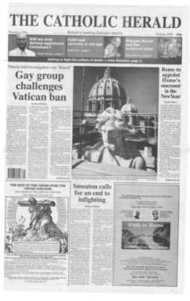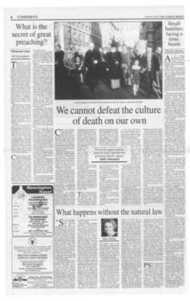Page 8, 30th July 1999
Page 8

Report an error
Noticed an error on this page?If you've noticed an error in this article please click here to report it.
Tags
Share
Related articles
Mary's Mission
Rome Says No To 'promoting' Mary
Mary Co-redemptrix?
Mary's Role In The Church
First Of The Saved Paves The Way
Mary and the Fathers
Marianism protected the early Church against heresy, says Margot Lawrence
Mary and the Fathers of the Church: The Blessed Virgin in Patristic Thought by Luigi Gambero, Ignatius Press £16.95.
THIS IS ONE OF THE BEST and most important books to come my way for a long time. For the writer, Fr Luigi Gambero, it has clearly been a labour of deep love as well as most profound scholarship. The result is a work -- that as well as being a definitive resource for scholars of the subject and period generally, will give delight and no little enlightenment to the ordinary reader devoted to the Blessed Virgin Mary.
To show how the theology of the Incarnation and the Virgin Mary developed over 750 years in only 450 pages makes for a book that must concentrate on essentials, and this is gracefully done. We are told a good deal about every figure mentioned, with detailed reference for further studies. Gambero breaks the period down into four subsections, the Apostolic Age to the Council of Nicea, Nicea to the Council of Ephesus, and so on, then takes the major figures of each era, such as Augustine or Jerome, Isidore of Seville or Gregory the Great, and examines their individual contributions, with brief quotations from their works, plus, for each, a longer reading to give a satisfying draught from the clear fountain of early scholarship.
He takes issue at times with even the most revered of the Fathers, but it is always done with respect and making due allowance for contemporary influences. Marian scholarship, it becomes clear, was largely and frequently the response to heretical ideas that emerged even very early on, demanding clear reflection.
The so-called Proto-Evangelion of James is the document which gives us the names of Joachim and Anna as Mary's parents, and was a work which largely conditioned popular devotion in the first century. Gambero suggests it was written partly to counter Docetism, a heresy that denied that Christ was true man.
The earliest Marian prayer of which we have record is in a third century papyrus now in the Rylands Library, Manchester. It entered into both Eastern and Western liturgies and is the first such writing to use the term Theotokos, mother of God, a term especially expounded by Origen (b. 185 approx) who also takes it for granted that Mary's perpetual virginity was an integral part of the faith. The term, however, gave rise to many arguments and was not introduced into official documents before the Council of Ephesus, 431 AD. Justin Martyr, "a simple Christian layman" was probably the first to use the Eve-Mary parallel, a comparison which led to the early Fathers formally developing a view of Mary's role in the "economy of salvation" which was also to be of great value in combating the Gnostic heresy.
After the threat of martyrdom was removed by Constantine's recognition of the church, devotion to Mary became more widespread, as those who would earlier have prepared themselves to sacrifice their Jives, derided that the sacrifice of celibacy should be theirs instead, and made Mary's perpetual virginity their inspiration.
Gregory of Nazanius (d.390) was a Bishop of Constantinople who built a chapel dedicated to Mary, and formulated a theory of her purity which seems to be an early intuition of the doctrine defined in 1854 as the Immaculate Conception. Gregory is also one of the earliest to mention prayer to Mary and its efficacious outcome.
Ambrose especially praised Mary's simple modesty and humility, and was the first Christian author to refer to Mary as the type and model of the church (a view cited by Vatican II in our own century).
By Ambrose's day, heresy was rampant and one of the most forceful defenders of true faith was Epiphanus, Bishop of Salamis, whose writings are of special historical value as showing us the nature of the heresies he was contending with. Among them was the Kollyridian sect which, in imitation of earlier pagan practices, granted priestly authority to women.
AS WELL AS COVERING all the famous figures, the book introduces us to many other admirable or loveable ones about whom we may not have known much previously. One such is Caelius Sedulius, a liturgical poet of the early fifth century whose compositions have become part of the heritage of the Latin church. Another, Romanos the Melodist, was the deviser of the Kontakion,a homily in verse form, in which he celebrated the Blessed Virgin with fitting beauty, including one for her birth-date, September 9.
There is also the unknown author of what is called the Akathist Hymn, whose identity has never been established, though he was clearly both a great poet and great theologian. One is thankful to the author of this book for bringing us in touch with such writers who could speak for all the hundreds of thousands of simple devotees of Mary.
The translator, Thomas Buffer, must be commended for his excellent work.
blog comments powered by Disqus













